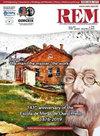Damage evolution in a tensile specimen of a ductile stainless steel
Q3 Earth and Planetary Sciences
引用次数: 3
Abstract
This paper presents a study about the fracture mechanism of a ferritic stainless steel (UNS S44400 type) during a tensile test. The applied materials for the experimental procedures were 25 specimens of the steel, machined in the rolling direction. Each specimen was submitted to standard polishing procedures. One of the samples, in the original state, was structurally characterized by reflected light optical microscopy. The other samples were submitted to tensile tests with a constant displacement rate. Three samples were tested until failure (complete tests) and the others just until specific strain values, when the tests were interrupted and the samples were characterized by using optical and scanning electron microscopy. The main objective of these characterizations was to evaluate the structural damage evolution and to identify the fracture mechanism for the tested conditions. A methodology to quantify the damage evolution by surface roughness, identified by optical microscopy, was proposed. A new index - Damage by Diffuse Reflection Index (DRI) - was proposed to quantify the damage evolution in function of the specimen deformation. It was possible to confirm the ductile behavior of the studied steel and that the main fracture mechanism was the traditional dimpled rupture.延性不锈钢拉伸试样的损伤演化
本文研究了一种铁素体不锈钢(UNS S44400型)在拉伸试验中的断裂机理。试验采用的材料为轧制方向加工的25个钢试样。每个样品都被提交到标准的抛光程序。其中一个样品在原始状态下,用反射光光学显微镜进行了结构表征。其他样品以恒定的位移率进行拉伸试验。三个样品被测试到失效(完整测试),其他样品被测试到特定的应变值,这时测试被中断,样品被使用光学和扫描电子显微镜表征。这些表征的主要目的是评估结构损伤演变,并确定测试条件下的断裂机制。提出了一种通过光学显微镜识别表面粗糙度来量化损伤演变的方法。提出了一种新的指标——漫反射损伤指数(DRI)来量化损伤随试样变形的演化过程。结果表明,所研究的钢具有良好的延性,主要断裂机制为传统的韧窝断裂。
本文章由计算机程序翻译,如有差异,请以英文原文为准。
求助全文
约1分钟内获得全文
求助全文
来源期刊

Rem-Revista Escola De Minas
工程技术-工程:土木
自引率
0.00%
发文量
0
审稿时长
6-12 weeks
期刊介绍:
REM – International Engineering Journal (antigua REM – Revista Escola de Minas) es la primera revista técnica de Sudamérica. Fue fundada en enero de 1936 por los estudiantes de la Escuela de Minas de Ouro Preto y desde entonces se ha especializado en la publicación de artículos en las áreas de la Ingeniería Civil, Geología, Metalurgia y Materiales y, Minería y Mecánica y Energía.
Su objetivo es servir como un medio de publicación para los trabajos técnicos y científicos originales de investigadores nacionales y extranjeros en esas áreas. Contribuciones originales (artículos y cartas) son aceptadas. Artículos de revisión dependen de la invitación y/o análisis de los Editores.
El envío de artículos para su publicación implica que el trabajo no ha sido publicado previamente, que no está siendo presentado para su publicación en otra revista y no se publicará en otro lugar, en la misma forma, sin el permiso, por escrito, de los Editores/Autores.
 求助内容:
求助内容: 应助结果提醒方式:
应助结果提醒方式:


